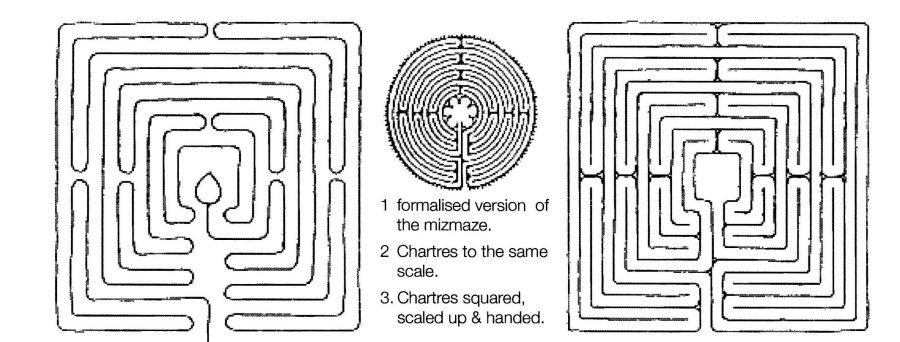The St Catherine's Hill Mizmaze - TrustNews Jun 14
More famous and sophisticated is the mediaeval stone maze laid out on the floor of Chartres Cathedral, about 40 feet in diameter, it stretches from one side of the nave to the other. These ancient mazes, which are sometimes called labyrinths, are not mazes at all in the sense we use the word nowadays, because they are not puzzles with choices of route, but ‘unicursal’, having a single uninterrupted path leading inevitably from the entrance to the centre. They all seem to be variations of the same pattern, whether the church mazes of northern France, English mazes cut into the turf, or as depicted on Cretan coins of the 6th century BC. Possibly over 4,000 years old, a maze scratched on a rock face in Sardinia is believed to be the oldest known example.
On the wall of an 11th century church in Italy there is a small maze with a Latin inscription describing it as the labyrinth designed by Daedalus for King Minos of Crete. I do not know how this affects other people but it makes the hairs stand up on the back of my neck to think that the pattern I shuffled around in the rough grass with my children could be the very same which was known to King Minos thousands of years ago in a world I had looked upon as legend. This is not the only link to Daedalus either, for it seems that until it was taken for munitions during the Napoleonic wars there was a bronze plate at the centre of the Chartres maze depicting a minotaur.
There are 16 of these early mediaeval mazes left in Europe, but only 8 turf mazes survive in England and our mizmaze is one of only two with this name, the other being at Breamore in the New Forest. I have spotted small mazes in the mosaic floor of a Roman city in Portugal and on the wall of a medieval ruin in Ireland - it is worth keeping your eyes peeled as the discovery is something of a thrill. There are also an increasing number of modern replicas; how would it be if one were included when the Broadway is repaved?
What were they all for, these unicursal mazes? There are books and library references exploring the subject in great detail, but l shall only pass on one or two certainties and some conjecture. Obviously the mazes had religious significance, Christian at least in the cathedrals and probably a mixture of Christian and pre-Christian in the countryside.
The pre-Christian symbolism is perhaps to do with the sun and the moon as there appear to be links with the calendar in the layout of the early mazes, linked perhaps with stone circles and ancient games like hopscotch. The Christian purpose may have been to create a ritual pilgrimage for those who could not travel to the Holy Land, so that they might progress on their knees in prayer (each corner serving like a bead in a rosary), until they reached Jerusalem- as the centre was sometimes called. Some say that the return journey was also important, culminating as at Chartres with the blaze of light from the rose window, which it is claimed has a mathematical relationship with the maze.
Such theories can seem conclusive, with mathematical measurement turning into proof. It is confusing, then, to learn that there is historical evidence of the Chartres maze being used for religious games rather than pilgrimages. Apparently the King and his court would watch while the clergy sang and danced around the maze, lobbing some object from one to another in festive worship. One can certainly imagine something more along these lines on St. Catherine's Hill than pious Wintonians painstakingly shuffling around the damp turf on their knees.
Which reminds me that the Winchester maze is said to have become distorted because, when it was first re-cut by restorers, the pattern was misunderstood. As a result, the bare earth has become the route, where it should form the lines of division between the encircling turf paths. And here there is another puzzle: what should be the pattern of the maze? There are 11 circular paths at Chartres but only 8 strips of turf at Winchester. Have 3 been lost? Certainly the centre seems over large in proportion and an outer ring could easily have been lost. So perhaps there should be 2 more in the centre and 1 outside? Or was it always an 8 ring version?
Another possibility is that there is a missing boundary line in each grass loop. This would make 16 paths compared with 11 at Chartres. Another interesting difference which may be relevant is that Chartres and other mazes tend to tease the traveller early on by leading the pilgrim close to the centre more than once before swinging away, whereas in our mizmaze the journey progresses by simpler stages towards the centre.
I remain mystified and hope that someone will see a clue which I have missed. All you need is some tracing paper and a great deal of patience!

The mizmaze now has a narrow earthen path between wide grass divisions (left) but might once have had a wider grass path between narrow ditches, more like the Chartres pattern (right). How would this have looked? Suggestions welcome....
